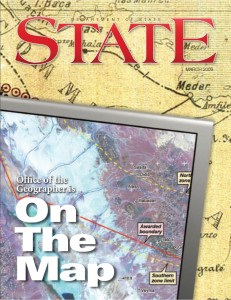‘Disruption is a theory: a conceptual model of cause and effect that makes it possible to better predict the outcomes of competitive battles in different circumstances’ — The Innovators Solution
My PhD dissertation at the University of Kansas is entitled “The Disruptive Potential of GIS 2.0: An application in the humanitarian domain”. The research involves several interrelated philosophical, technological, and methodological components, but at its core, it is about building a new way to harness the power of geographic analysis. In short, the idea is to show how Geographic Information Systems (GIS) has evolved into something different than it was before, explore the dynamics of that evolution, then build new tools and methods that capitalize on those dynamics.
The foundation of the argument is that a new generation of digital geographic tools, defined here as GIS 2.0, have completely changed how core GIS processes are implemented. While the core functions of a GIS remain the same — the creation, storage, analysis, visualization, and dissemination of geographic data — the number of software packages capable of implementing spatial functions and the distribution capacity of the Internet have fundamentally changed the desktop GIS paradigm. Driving GIS 2.0 is a converging set of technology trends including open source software, decreasing computation costs, ubiquitous data networks, mobile phones, location-based services, spatial database, and cloud computing.The most significant, open source software, has dramatically expanded access to geographic data and spatial analysis by lowering the barrier to entry into geographic computing. This expansion is leading to a new set of business models and organizations built around geographic data and analysis. Understanding how and why these trends converged, and what it means for the future, requires a conceptual framework that embeds the ideas of the Open Source Paradigm Shift and Commons-based Peer Production within the larger context of Disruptive Innovation Theory .
While there is a philosophical element to this argument, the goal of the dissertation is to utilize the insights provided by disruptive innovation theory to build geographic systems and processes that can actually make a difference in how the humanitarian community responds to a complex emergency. It has been long recognized that geographic analysis can benefit the coordination and response to complex emergencies , yet the deployment of GIS has been hampered by a set of issues related to cost, training, data quality, and data collection standards . Using GIS 2.0 concepts there is an opportunity to overcome these issues, but doing so requires new technological and methodological approaches. With utility as a goal, the research is structured around general three sections:
- GIS 2.0 Philosophy: Exploring the fundamental reorganization of GIS processes, and building a conceptual model, based on disruptive innovation theory, for explaining that evolution and predicting future changes
- GIS 2.0 Technology: Utilizing GIS 2.0 concepts build the “CyberGIS”, a geographic computing infrastructure constructed entirely from free and open source software
- GIS 2.0 Methodology: Leverage the CyberGIS and GIS 2.0 concepts to build the “Imagery to the Crowd” process, a new methodology for crowdsourcing geographic data that can be deployed in a range of humanitarian applications
In the next series of posts I will explore each of the points above. My goal is to complete the dissertation in the coming months and I want to use this blog as a staging ground for drafts, chapters, and articles that can be submitted to my committee. As such they will likely be a bit rough. I am a perfectionist in my writing, which only serves to completely slow down my productivity, so hopefully this will force me to “release early and often.”
The core arguments of GIS 2.0 were originally conceived during 2006-2008, so they are a bit dated now. At the time there was really only anecdotal evidence to support the argument that the same Web 2.0 forces that built Wikipedia and disrupted the encyclopedia market were going to impact GIS. However, with the continued rise of FOSS4G, OpenStreetMap, and now the Humanitarian OpenStreetMap Team (HOT), it feels almost redundant to be making this argument now. Additionally, from the technology perspective there are lots of individuals and groups out there doing more cutting edge work than I ever will, but I hope the combination of philosophical approach and actual implementation can be a contribution to the discipline of geography — and more importantly, help the humanitarian community be more effective.
As always, constructive comments are welcome.
{1268173:2AVDKCPR};{1268173:I4HVWUJ7};{1268173:BQCTE8J9};{1268173:PBWDQ5A9};{1268173:2AVDKCPR};{1268173:Z87D68PV};{1268173:AAGHMPCB};{1268173:HQZ4CERM};{1268173:83JHAUN4};{1268173:HRXTS6D6}
annals-of-the-association-of-american-geographers
creator
asc
0
222
%7B%22status%22%3A%22success%22%2C%22updateneeded%22%3Afalse%2C%22instance%22%3A%22zotpress-b40f2e9fc1d1bcc077435a49db2a185f%22%2C%22meta%22%3A%7B%22request_last%22%3A0%2C%22request_next%22%3A0%2C%22used_cache%22%3Atrue%7D%2C%22data%22%3A%5B%7B%22key%22%3A%22HQZ4CERM%22%2C%22library%22%3A%7B%22type%22%3A%22user%22%2C%22id%22%3A1268173%2C%22name%22%3A%22disruptivegeo%22%2C%22links%22%3A%7B%22alternate%22%3A%7B%22href%22%3A%22https%3A%5C%2F%5C%2Fwww.zotero.org%5C%2Fdisruptivegeo%22%2C%22type%22%3A%22text%5C%2Fhtml%22%7D%7D%7D%2C%22meta%22%3A%7B%22creatorSummary%22%3A%22National%20Research%20Council%22%2C%22parsedDate%22%3A%222007%22%2C%22numChildren%22%3A0%7D%2C%22bib%22%3A%22%3Cdiv%20class%3D%5C%22csl-bib-body%5C%22%20style%3D%5C%22line-height%3A%201.35%3B%20%5C%22%3E%5Cn%20%20%3Cdiv%20class%3D%5C%22csl-entry%5C%22%3ENational%20Research%20Council.%202007.%20%3Ci%3ESuccessful%20response%20starts%20with%20a%20map%3A%20improving%20geospatial%20support%20for%20disaster%20management%3C%5C%2Fi%3E.%20Washington%2C%20D.C%3A%20National%20Academies%20Press.%3C%5C%2Fdiv%3E%5Cn%3C%5C%2Fdiv%3E%22%2C%22data%22%3A%7B%22key%22%3A%22HQZ4CERM%22%2C%22version%22%3A721%2C%22itemType%22%3A%22book%22%2C%22title%22%3A%22Successful%20response%20starts%20with%20a%20map%3A%20improving%20geospatial%20support%20for%20disaster%20management%22%2C%22creators%22%3A%5B%7B%22creatorType%22%3A%22author%22%2C%22firstName%22%3A%22%22%2C%22lastName%22%3A%22National%20Research%20Council%22%7D%5D%2C%22abstractNote%22%3A%22%22%2C%22series%22%3A%22%22%2C%22seriesNumber%22%3A%22%22%2C%22volume%22%3A%22%22%2C%22numberOfVolumes%22%3A%22%22%2C%22edition%22%3A%22%22%2C%22place%22%3A%22Washington%2C%20D.C%22%2C%22publisher%22%3A%22National%20Academies%20Press%22%2C%22date%22%3A%222007%22%2C%22numPages%22%3A%22184%22%2C%22language%22%3A%22%22%2C%22ISBN%22%3A%220-309-10340-1%22%2C%22shortTitle%22%3A%22Successful%20response%20starts%20with%20a%20map%22%2C%22url%22%3A%22%22%2C%22accessDate%22%3A%22%22%2C%22archive%22%3A%22%22%2C%22archiveLocation%22%3A%22%22%2C%22libraryCatalog%22%3A%22Library%20of%20Congress%20ISBN%22%2C%22callNumber%22%3A%22G70.215.U6%20N378%202007%22%2C%22rights%22%3A%22%22%2C%22extra%22%3A%22%22%2C%22collections%22%3A%5B%22TF4FCI5U%22%5D%2C%22relations%22%3A%7B%7D%2C%22dateAdded%22%3A%222013-03-13T03%3A08%3A22Z%22%2C%22dateModified%22%3A%222017-04-02T17%3A20%3A40Z%22%7D%7D%2C%7B%22key%22%3A%22PBWDQ5A9%22%2C%22library%22%3A%7B%22type%22%3A%22user%22%2C%22id%22%3A1268173%2C%22name%22%3A%22disruptivegeo%22%2C%22links%22%3A%7B%22alternate%22%3A%7B%22href%22%3A%22https%3A%5C%2F%5C%2Fwww.zotero.org%5C%2Fdisruptivegeo%22%2C%22type%22%3A%22text%5C%2Fhtml%22%7D%7D%7D%2C%22meta%22%3A%7B%22creatorSummary%22%3A%22Benkler%22%2C%22parsedDate%22%3A%222002%22%2C%22numChildren%22%3A0%7D%2C%22bib%22%3A%22%3Cdiv%20class%3D%5C%22csl-bib-body%5C%22%20style%3D%5C%22line-height%3A%201.35%3B%20%5C%22%3E%5Cn%20%20%3Cdiv%20class%3D%5C%22csl-entry%5C%22%3EBenkler%2C%20Y.%202002.%20Coase%26%23x2019%3Bs%20Penguin%2C%20or%2C%20Linux%20and%20%26%23x201C%3BThe%20Nature%20of%20the%20Firm.%26%23x201D%3B%20%3Ci%3EYale%20Law%20Journal%3C%5C%2Fi%3E%20112%20%283%29%3A369%26%23x2013%3B446.%3C%5C%2Fdiv%3E%5Cn%3C%5C%2Fdiv%3E%22%2C%22data%22%3A%7B%22key%22%3A%22PBWDQ5A9%22%2C%22version%22%3A721%2C%22itemType%22%3A%22journalArticle%22%2C%22title%22%3A%22Coase%27s%20Penguin%2C%20or%2C%20Linux%20and%20%5C%22The%20Nature%20of%20the%20Firm%5C%22%22%2C%22creators%22%3A%5B%7B%22creatorType%22%3A%22author%22%2C%22firstName%22%3A%22Yochai%22%2C%22lastName%22%3A%22Benkler%22%7D%5D%2C%22abstractNote%22%3A%22%22%2C%22publicationTitle%22%3A%22Yale%20Law%20Journal%22%2C%22volume%22%3A%22112%22%2C%22issue%22%3A%223%22%2C%22pages%22%3A%22369-446%22%2C%22date%22%3A%222002%22%2C%22series%22%3A%22%22%2C%22seriesTitle%22%3A%22%22%2C%22seriesText%22%3A%22%22%2C%22journalAbbreviation%22%3A%22Yale%20Law%20Journal%22%2C%22language%22%3A%22%22%2C%22DOI%22%3A%22%22%2C%22ISSN%22%3A%220044-0094%22%2C%22shortTitle%22%3A%22%22%2C%22url%22%3A%22%22%2C%22accessDate%22%3A%22%22%2C%22archive%22%3A%22%22%2C%22archiveLocation%22%3A%22%22%2C%22libraryCatalog%22%3A%22%22%2C%22callNumber%22%3A%22%22%2C%22rights%22%3A%22%22%2C%22extra%22%3A%22%22%2C%22collections%22%3A%5B%22TF4FCI5U%22%5D%2C%22relations%22%3A%7B%7D%2C%22dateAdded%22%3A%222013-03-13T02%3A12%3A06Z%22%2C%22dateModified%22%3A%222017-04-02T17%3A20%3A40Z%22%7D%7D%2C%7B%22key%22%3A%22Z87D68PV%22%2C%22library%22%3A%7B%22type%22%3A%22user%22%2C%22id%22%3A1268173%2C%22name%22%3A%22disruptivegeo%22%2C%22links%22%3A%7B%22alternate%22%3A%7B%22href%22%3A%22https%3A%5C%2F%5C%2Fwww.zotero.org%5C%2Fdisruptivegeo%22%2C%22type%22%3A%22text%5C%2Fhtml%22%7D%7D%7D%2C%22meta%22%3A%7B%22creatorSummary%22%3A%22Wood%22%2C%22parsedDate%22%3A%222000%22%2C%22numChildren%22%3A0%7D%2C%22bib%22%3A%22%3Cdiv%20class%3D%5C%22csl-bib-body%5C%22%20style%3D%5C%22line-height%3A%201.35%3B%20%5C%22%3E%5Cn%20%20%3Cdiv%20class%3D%5C%22csl-entry%5C%22%3EWood%2C%20W.%20B.%202000.%20Complex%20emergency%20response%20planning%20and%20coordination%3A%20Potential%20GIS%20applications.%20%3Ci%3EGeopolitics%3C%5C%2Fi%3E%205%20%281%29%3A19%26%23x2013%3B36.%20%3Ca%20href%3D%27http%3A%5C%2F%5C%2Fwww.tandfonline.com%5C%2Fdoi%5C%2Fabs%5C%2F10.1080%5C%2F14650040008407665%27%3Ehttp%3A%5C%2F%5C%2Fwww.tandfonline.com%5C%2Fdoi%5C%2Fabs%5C%2F10.1080%5C%2F14650040008407665%3C%5C%2Fa%3E%20%28last%20accessed%207%20March%202013%29.%3C%5C%2Fdiv%3E%5Cn%3C%5C%2Fdiv%3E%22%2C%22data%22%3A%7B%22key%22%3A%22Z87D68PV%22%2C%22version%22%3A721%2C%22itemType%22%3A%22journalArticle%22%2C%22title%22%3A%22Complex%20emergency%20response%20planning%20and%20coordination%3A%20Potential%20GIS%20applications%22%2C%22creators%22%3A%5B%7B%22creatorType%22%3A%22author%22%2C%22firstName%22%3A%22William%20B.%22%2C%22lastName%22%3A%22Wood%22%7D%5D%2C%22abstractNote%22%3A%22%22%2C%22publicationTitle%22%3A%22Geopolitics%22%2C%22volume%22%3A%225%22%2C%22issue%22%3A%221%22%2C%22pages%22%3A%2219-36%22%2C%22date%22%3A%2206%5C%2F2000%22%2C%22series%22%3A%22%22%2C%22seriesTitle%22%3A%22%22%2C%22seriesText%22%3A%22%22%2C%22journalAbbreviation%22%3A%22%22%2C%22language%22%3A%22%22%2C%22DOI%22%3A%2210.1080%5C%2F14650040008407665%22%2C%22ISSN%22%3A%221465-0045%2C%201557-3028%22%2C%22shortTitle%22%3A%22Complex%20emergency%20response%20planning%20and%20coordination%22%2C%22url%22%3A%22http%3A%5C%2F%5C%2Fwww.tandfonline.com%5C%2Fdoi%5C%2Fabs%5C%2F10.1080%5C%2F14650040008407665%22%2C%22accessDate%22%3A%222013-03-07T02%3A48%3A44Z%22%2C%22archive%22%3A%22%22%2C%22archiveLocation%22%3A%22%22%2C%22libraryCatalog%22%3A%22CrossRef%22%2C%22callNumber%22%3A%22%22%2C%22rights%22%3A%22%22%2C%22extra%22%3A%22%22%2C%22collections%22%3A%5B%22TF4FCI5U%22%5D%2C%22relations%22%3A%7B%22dc%3Areplaces%22%3A%22http%3A%5C%2F%5C%2Fzotero.org%5C%2Fusers%5C%2F1268173%5C%2Fitems%5C%2FSKM9R9VV%22%7D%2C%22dateAdded%22%3A%222013-03-07T02%3A48%3A44Z%22%2C%22dateModified%22%3A%222017-04-02T17%3A20%3A40Z%22%7D%7D%2C%7B%22key%22%3A%2283JHAUN4%22%2C%22library%22%3A%7B%22type%22%3A%22user%22%2C%22id%22%3A1268173%2C%22name%22%3A%22disruptivegeo%22%2C%22links%22%3A%7B%22alternate%22%3A%7B%22href%22%3A%22https%3A%5C%2F%5C%2Fwww.zotero.org%5C%2Fdisruptivegeo%22%2C%22type%22%3A%22text%5C%2Fhtml%22%7D%7D%7D%2C%22meta%22%3A%7B%22creatorSummary%22%3A%22Verjee%22%2C%22parsedDate%22%3A%222007%22%2C%22numChildren%22%3A1%7D%2C%22bib%22%3A%22%3Cdiv%20class%3D%5C%22csl-bib-body%5C%22%20style%3D%5C%22line-height%3A%201.35%3B%20%5C%22%3E%5Cn%20%20%3Cdiv%20class%3D%5C%22csl-entry%5C%22%3EVerjee%2C%20F.%202007.%20An%20assessment%20of%20the%20utility%20of%20GIS-based%20analysis%20to%20support%20the%20coordination%20of%20humanitarian%20assistance.%20%3Ca%20href%3D%27http%3A%5C%2F%5C%2Fpqdtopen.proquest.com%5C%2F%23viewpdf%3Fdispub%3D3297449%27%3Ehttp%3A%5C%2F%5C%2Fpqdtopen.proquest.com%5C%2F%23viewpdf%3Fdispub%3D3297449%3C%5C%2Fa%3E%20%28last%20accessed%207%20March%202013%29.%3C%5C%2Fdiv%3E%5Cn%3C%5C%2Fdiv%3E%22%2C%22data%22%3A%7B%22key%22%3A%2283JHAUN4%22%2C%22version%22%3A721%2C%22itemType%22%3A%22thesis%22%2C%22title%22%3A%22An%20assessment%20of%20the%20utility%20of%20GIS-based%20analysis%20to%20support%20the%20coordination%20of%20humanitarian%20assistance%22%2C%22creators%22%3A%5B%7B%22creatorType%22%3A%22author%22%2C%22firstName%22%3A%22Firoz%22%2C%22lastName%22%3A%22Verjee%22%7D%5D%2C%22abstractNote%22%3A%22%22%2C%22thesisType%22%3A%22Dissertation%22%2C%22university%22%3A%22George%20Washington%20University%22%2C%22place%22%3A%22Washington%2C%20D.C.%22%2C%22date%22%3A%222007%22%2C%22numPages%22%3A%22259%22%2C%22language%22%3A%22English%22%2C%22shortTitle%22%3A%22%22%2C%22url%22%3A%22http%3A%5C%2F%5C%2Fpqdtopen.proquest.com%5C%2F%23viewpdf%3Fdispub%3D3297449%22%2C%22accessDate%22%3A%222013-03-07T00%3A31%3A13Z%22%2C%22archive%22%3A%22%22%2C%22archiveLocation%22%3A%22%22%2C%22libraryCatalog%22%3A%22%22%2C%22callNumber%22%3A%22%22%2C%22rights%22%3A%22%22%2C%22extra%22%3A%222007%20October%2016%22%2C%22collections%22%3A%5B%22TF4FCI5U%22%5D%2C%22relations%22%3A%7B%7D%2C%22dateAdded%22%3A%222013-03-07T00%3A31%3A13Z%22%2C%22dateModified%22%3A%222017-04-02T17%3A20%3A40Z%22%7D%7D%2C%7B%22key%22%3A%22I4HVWUJ7%22%2C%22library%22%3A%7B%22type%22%3A%22user%22%2C%22id%22%3A1268173%2C%22name%22%3A%22disruptivegeo%22%2C%22links%22%3A%7B%22alternate%22%3A%7B%22href%22%3A%22https%3A%5C%2F%5C%2Fwww.zotero.org%5C%2Fdisruptivegeo%22%2C%22type%22%3A%22text%5C%2Fhtml%22%7D%7D%7D%2C%22meta%22%3A%7B%22creatorSummary%22%3A%22Clarke%22%2C%22parsedDate%22%3A%222001%22%2C%22numChildren%22%3A0%7D%2C%22bib%22%3A%22%3Cdiv%20class%3D%5C%22csl-bib-body%5C%22%20style%3D%5C%22line-height%3A%201.35%3B%20%5C%22%3E%5Cn%20%20%3Cdiv%20class%3D%5C%22csl-entry%5C%22%3EClarke%2C%20K.%20C.%202001.%20%3Ci%3EGetting%20started%20with%20geographic%20information%20systems%3C%5C%2Fi%3E%203rd%20ed.%20Upper%20Saddle%20River%2C%20N.J%3A%20Prentice%20Hall.%3C%5C%2Fdiv%3E%5Cn%3C%5C%2Fdiv%3E%22%2C%22data%22%3A%7B%22key%22%3A%22I4HVWUJ7%22%2C%22version%22%3A721%2C%22itemType%22%3A%22book%22%2C%22title%22%3A%22Getting%20started%20with%20geographic%20information%20systems%22%2C%22creators%22%3A%5B%7B%22creatorType%22%3A%22author%22%2C%22firstName%22%3A%22Keith%20C.%22%2C%22lastName%22%3A%22Clarke%22%7D%5D%2C%22abstractNote%22%3A%22%22%2C%22series%22%3A%22Prentice%20Hall%20series%20in%20geographic%20information%20science%22%2C%22seriesNumber%22%3A%22%22%2C%22volume%22%3A%22%22%2C%22numberOfVolumes%22%3A%22%22%2C%22edition%22%3A%223rd%20ed%22%2C%22place%22%3A%22Upper%20Saddle%20River%2C%20N.J%22%2C%22publisher%22%3A%22Prentice%20Hall%22%2C%22date%22%3A%222001%22%2C%22numPages%22%3A%22352%22%2C%22language%22%3A%22%22%2C%22ISBN%22%3A%220-13-016829-7%22%2C%22shortTitle%22%3A%22%22%2C%22url%22%3A%22%22%2C%22accessDate%22%3A%22%22%2C%22archive%22%3A%22%22%2C%22archiveLocation%22%3A%22%22%2C%22libraryCatalog%22%3A%22Library%20of%20Congress%20ISBN%22%2C%22callNumber%22%3A%22G70.212%20.C57%202001%22%2C%22rights%22%3A%22%22%2C%22extra%22%3A%22%22%2C%22collections%22%3A%5B%22TF4FCI5U%22%5D%2C%22relations%22%3A%7B%7D%2C%22dateAdded%22%3A%222013-01-26T20%3A53%3A48Z%22%2C%22dateModified%22%3A%222017-04-02T17%3A20%3A40Z%22%7D%7D%2C%7B%22key%22%3A%22AAGHMPCB%22%2C%22library%22%3A%7B%22type%22%3A%22user%22%2C%22id%22%3A1268173%2C%22name%22%3A%22disruptivegeo%22%2C%22links%22%3A%7B%22alternate%22%3A%7B%22href%22%3A%22https%3A%5C%2F%5C%2Fwww.zotero.org%5C%2Fdisruptivegeo%22%2C%22type%22%3A%22text%5C%2Fhtml%22%7D%7D%7D%2C%22meta%22%3A%7B%22creatorSummary%22%3A%22Kelmelis%20et%20al.%22%2C%22parsedDate%22%3A%222006%22%2C%22numChildren%22%3A0%7D%2C%22bib%22%3A%22%3Cdiv%20class%3D%5C%22csl-bib-body%5C%22%20style%3D%5C%22line-height%3A%201.35%3B%20%5C%22%3E%5Cn%20%20%3Cdiv%20class%3D%5C%22csl-entry%5C%22%3EKelmelis%2C%20J.%20A.%20.%2C%20L.%20Schwartz%2C%20C.%20Christian%2C%20M.%20Crawford%2C%20and%20D.%20King.%202006.%20Use%20of%20Geographic%20Information%20in%20Response%20to%20the%20Sumatra-Andaman%20Earthquake%20and%20Indian%20Ocean%20Tsunami%20of%20December%2026%2C%202004.%20%3Ci%3EPhotogrammetric%20Engineering%20and%20Remote%20Sensing%3C%5C%2Fi%3E%2072%3A862%26%23x2013%3B876.%3C%5C%2Fdiv%3E%5Cn%3C%5C%2Fdiv%3E%22%2C%22data%22%3A%7B%22key%22%3A%22AAGHMPCB%22%2C%22version%22%3A721%2C%22itemType%22%3A%22journalArticle%22%2C%22title%22%3A%22Use%20of%20Geographic%20Information%20in%20Response%20to%20the%20Sumatra-Andaman%20Earthquake%20and%20Indian%20Ocean%20Tsunami%20of%20December%2026%2C%202004%22%2C%22creators%22%3A%5B%7B%22creatorType%22%3A%22author%22%2C%22firstName%22%3A%22John%20A.%3B%22%2C%22lastName%22%3A%22Kelmelis%22%7D%2C%7B%22creatorType%22%3A%22author%22%2C%22firstName%22%3A%22Lee%3B%22%2C%22lastName%22%3A%22Schwartz%22%7D%2C%7B%22creatorType%22%3A%22author%22%2C%22firstName%22%3A%22Carol%3B%22%2C%22lastName%22%3A%22Christian%22%7D%2C%7B%22creatorType%22%3A%22author%22%2C%22firstName%22%3A%22Melba%3B%22%2C%22lastName%22%3A%22Crawford%22%7D%2C%7B%22creatorType%22%3A%22author%22%2C%22firstName%22%3A%22Dennis%3B%22%2C%22lastName%22%3A%22King%22%7D%5D%2C%22abstractNote%22%3A%22%22%2C%22publicationTitle%22%3A%22Photogrammetric%20Engineering%20and%20Remote%20Sensing%22%2C%22volume%22%3A%2272%22%2C%22issue%22%3A%22%22%2C%22pages%22%3A%22862-876%22%2C%22date%22%3A%222006%22%2C%22series%22%3A%22%22%2C%22seriesTitle%22%3A%22%22%2C%22seriesText%22%3A%22%22%2C%22journalAbbreviation%22%3A%22%22%2C%22language%22%3A%220099-1112%22%2C%22DOI%22%3A%22%22%2C%22ISSN%22%3A%22%22%2C%22shortTitle%22%3A%22Use%20of%20Geographic%20Information%20in%20Response%20to%20the%20Sumatra-Andaman%20Earthquake%20and%20Indian%20Ocean%20Tsunami%20of%20December%2026%2C%202004%22%2C%22url%22%3A%22%22%2C%22accessDate%22%3A%22%22%2C%22archive%22%3A%22%22%2C%22archiveLocation%22%3A%22%22%2C%22libraryCatalog%22%3A%22%22%2C%22callNumber%22%3A%22%22%2C%22rights%22%3A%22%22%2C%22extra%22%3A%228%22%2C%22collections%22%3A%5B%22TF4FCI5U%22%5D%2C%22relations%22%3A%7B%7D%2C%22dateAdded%22%3A%222013-01-22T04%3A22%3A58Z%22%2C%22dateModified%22%3A%222017-04-02T17%3A20%3A40Z%22%7D%7D%2C%7B%22key%22%3A%222AVDKCPR%22%2C%22library%22%3A%7B%22type%22%3A%22user%22%2C%22id%22%3A1268173%2C%22name%22%3A%22disruptivegeo%22%2C%22links%22%3A%7B%22alternate%22%3A%7B%22href%22%3A%22https%3A%5C%2F%5C%2Fwww.zotero.org%5C%2Fdisruptivegeo%22%2C%22type%22%3A%22text%5C%2Fhtml%22%7D%7D%7D%2C%22meta%22%3A%7B%22creatorSummary%22%3A%22Christensen%20and%20Raynor%22%2C%22parsedDate%22%3A%222003%22%2C%22numChildren%22%3A0%7D%2C%22bib%22%3A%22%3Cdiv%20class%3D%5C%22csl-bib-body%5C%22%20style%3D%5C%22line-height%3A%201.35%3B%20%5C%22%3E%5Cn%20%20%3Cdiv%20class%3D%5C%22csl-entry%5C%22%3EChristensen%2C%20C.%20M.%2C%20and%20M.%20E.%20Raynor.%202003.%20%3Ci%3EThe%20Innovator%26%23x2019%3Bs%20Solution%3A%20Creating%20and%20Sustaining%20Successful%20Growth%3C%5C%2Fi%3E.%20Boston%3A%20Harvard%20Business%20School%20Publishing.%3C%5C%2Fdiv%3E%5Cn%3C%5C%2Fdiv%3E%22%2C%22data%22%3A%7B%22key%22%3A%222AVDKCPR%22%2C%22version%22%3A721%2C%22itemType%22%3A%22book%22%2C%22title%22%3A%22The%20Innovator%27s%20Solution%3A%20Creating%20and%20Sustaining%20Successful%20Growth%22%2C%22creators%22%3A%5B%7B%22creatorType%22%3A%22author%22%2C%22firstName%22%3A%22Clayton%20M.%22%2C%22lastName%22%3A%22Christensen%22%7D%2C%7B%22creatorType%22%3A%22author%22%2C%22firstName%22%3A%22Michael%20E.%22%2C%22lastName%22%3A%22Raynor%22%7D%5D%2C%22abstractNote%22%3A%22%22%2C%22series%22%3A%22%22%2C%22seriesNumber%22%3A%22%22%2C%22volume%22%3A%22%22%2C%22numberOfVolumes%22%3A%22%22%2C%22edition%22%3A%22%22%2C%22place%22%3A%22Boston%22%2C%22publisher%22%3A%22Harvard%20Business%20School%20Publishing%22%2C%22date%22%3A%222003%22%2C%22numPages%22%3A%22304%22%2C%22language%22%3A%22%22%2C%22ISBN%22%3A%22%22%2C%22shortTitle%22%3A%22The%20Innovator%27s%20Solution%3A%20Creating%20and%20Sustaining%20Successful%20Growth%22%2C%22url%22%3A%22%22%2C%22accessDate%22%3A%22%22%2C%22archive%22%3A%22%22%2C%22archiveLocation%22%3A%22%22%2C%22libraryCatalog%22%3A%22%22%2C%22callNumber%22%3A%22%22%2C%22rights%22%3A%22%22%2C%22extra%22%3A%22%22%2C%22collections%22%3A%5B%22TF4FCI5U%22%5D%2C%22relations%22%3A%7B%7D%2C%22dateAdded%22%3A%222013-01-22T04%3A22%3A58Z%22%2C%22dateModified%22%3A%222017-04-02T17%3A20%3A40Z%22%7D%7D%2C%7B%22key%22%3A%22BQCTE8J9%22%2C%22library%22%3A%7B%22type%22%3A%22user%22%2C%22id%22%3A1268173%2C%22name%22%3A%22disruptivegeo%22%2C%22links%22%3A%7B%22alternate%22%3A%7B%22href%22%3A%22https%3A%5C%2F%5C%2Fwww.zotero.org%5C%2Fdisruptivegeo%22%2C%22type%22%3A%22text%5C%2Fhtml%22%7D%7D%7D%2C%22meta%22%3A%7B%22creatorSummary%22%3A%22von%20Hippel%22%2C%22parsedDate%22%3A%222005%22%2C%22numChildren%22%3A0%7D%2C%22bib%22%3A%22%3Cdiv%20class%3D%5C%22csl-bib-body%5C%22%20style%3D%5C%22line-height%3A%201.35%3B%20%5C%22%3E%5Cn%20%20%3Cdiv%20class%3D%5C%22csl-entry%5C%22%3Evon%20Hippel%2C%20E.%202005.%20Open%20Source%20Software%20Projects%20as%20User%20Innovation%20Networks.%20In%20%3Ci%3EPerspectives%20on%20Free%20and%20Open%20Source%20Software%3C%5C%2Fi%3E%2C%20eds.%20J.%20Feller%2C%20B.%20Fitzgerald%2C%20S.%20A.%20Hissam%2C%20and%20K.%20R.%20Lakhani%2C%20267%26%23x2013%3B278.%20Cambridge%3A%20MIT%20Press%20%3Ca%20href%3D%27http%3A%5C%2F%5C%2Fmitpress.mit.edu%5C%2Fbooks%5C%2Fperspectives-free-and-open-source-software%27%3Ehttp%3A%5C%2F%5C%2Fmitpress.mit.edu%5C%2Fbooks%5C%2Fperspectives-free-and-open-source-software%3C%5C%2Fa%3E.%3C%5C%2Fdiv%3E%5Cn%3C%5C%2Fdiv%3E%22%2C%22data%22%3A%7B%22key%22%3A%22BQCTE8J9%22%2C%22version%22%3A721%2C%22itemType%22%3A%22bookSection%22%2C%22title%22%3A%22Open%20Source%20Software%20Projects%20as%20User%20Innovation%20Networks%22%2C%22creators%22%3A%5B%7B%22creatorType%22%3A%22editor%22%2C%22firstName%22%3A%22Joseph%22%2C%22lastName%22%3A%22Feller%22%7D%2C%7B%22creatorType%22%3A%22editor%22%2C%22firstName%22%3A%22Brian%22%2C%22lastName%22%3A%22Fitzgerald%22%7D%2C%7B%22creatorType%22%3A%22editor%22%2C%22firstName%22%3A%22Scott%20A.%22%2C%22lastName%22%3A%22Hissam%22%7D%2C%7B%22creatorType%22%3A%22editor%22%2C%22firstName%22%3A%22Karim%20R.%22%2C%22lastName%22%3A%22Lakhani%22%7D%2C%7B%22creatorType%22%3A%22author%22%2C%22firstName%22%3A%22Eric%22%2C%22lastName%22%3A%22von%20Hippel%22%7D%5D%2C%22abstractNote%22%3A%22%22%2C%22bookTitle%22%3A%22Perspectives%20on%20Free%20and%20Open%20Source%20Software%22%2C%22series%22%3A%22%22%2C%22seriesNumber%22%3A%22%22%2C%22volume%22%3A%22%22%2C%22numberOfVolumes%22%3A%22%22%2C%22edition%22%3A%22%22%2C%22place%22%3A%22Cambridge%22%2C%22publisher%22%3A%22MIT%20Press%22%2C%22date%22%3A%222005%22%2C%22pages%22%3A%22267-278%22%2C%22language%22%3A%22%22%2C%22ISBN%22%3A%22%22%2C%22shortTitle%22%3A%22%22%2C%22url%22%3A%22http%3A%5C%2F%5C%2Fmitpress.mit.edu%5C%2Fbooks%5C%2Fperspectives-free-and-open-source-software%22%2C%22accessDate%22%3A%22%22%2C%22archive%22%3A%22%22%2C%22archiveLocation%22%3A%22%22%2C%22libraryCatalog%22%3A%22%22%2C%22callNumber%22%3A%22%22%2C%22rights%22%3A%22%22%2C%22extra%22%3A%22%22%2C%22collections%22%3A%5B%22TF4FCI5U%22%5D%2C%22relations%22%3A%7B%22dc%3Areplaces%22%3A%22http%3A%5C%2F%5C%2Fzotero.org%5C%2Fusers%5C%2F1268173%5C%2Fitems%5C%2FCAD4DNEE%22%7D%2C%22dateAdded%22%3A%222013-01-22T04%3A22%3A58Z%22%2C%22dateModified%22%3A%222017-04-02T17%3A20%3A40Z%22%7D%7D%2C%7B%22key%22%3A%22HRXTS6D6%22%2C%22library%22%3A%7B%22type%22%3A%22user%22%2C%22id%22%3A1268173%2C%22name%22%3A%22disruptivegeo%22%2C%22links%22%3A%7B%22alternate%22%3A%7B%22href%22%3A%22https%3A%5C%2F%5C%2Fwww.zotero.org%5C%2Fdisruptivegeo%22%2C%22type%22%3A%22text%5C%2Fhtml%22%7D%7D%7D%2C%22meta%22%3A%7B%22creatorSummary%22%3A%22O%27Reilly%22%2C%22parsedDate%22%3A%222007%22%2C%22numChildren%22%3A1%7D%2C%22bib%22%3A%22%3Cdiv%20class%3D%5C%22csl-bib-body%5C%22%20style%3D%5C%22line-height%3A%201.35%3B%20%5C%22%3E%5Cn%20%20%3Cdiv%20class%3D%5C%22csl-entry%5C%22%3EO%26%23x2019%3BReilly%2C%20T.%202007.%20What%20is%20Web%202.0%3A%20Design%20Patterns%20and%20Business%20Models%20for%20the%20Next%20Generation%20of%20Software.%20%3Ci%3ECommunications%20%26amp%3B%20Strategies%3C%5C%2Fi%3E%201%3A17.%20%3Ca%20href%3D%27http%3A%5C%2F%5C%2Fssrn.com%5C%2Fabstract%3D1008839%27%3Ehttp%3A%5C%2F%5C%2Fssrn.com%5C%2Fabstract%3D1008839%3C%5C%2Fa%3E%20%28last%20accessed%2022%20January%202013%29.%3C%5C%2Fdiv%3E%5Cn%3C%5C%2Fdiv%3E%22%2C%22data%22%3A%7B%22key%22%3A%22HRXTS6D6%22%2C%22version%22%3A721%2C%22itemType%22%3A%22journalArticle%22%2C%22title%22%3A%22What%20is%20Web%202.0%3A%20Design%20Patterns%20and%20Business%20Models%20for%20the%20Next%20Generation%20of%20Software%22%2C%22creators%22%3A%5B%7B%22creatorType%22%3A%22author%22%2C%22firstName%22%3A%22Tim%22%2C%22lastName%22%3A%22O%27Reilly%22%7D%5D%2C%22abstractNote%22%3A%22This%20paper%20was%20the%20first%20initiative%20to%20try%20to%20define%20Web%202.0%20and%20understand%20its%20implications%20for%20the%20next%20generation%20of%20software%2C%20looking%20at%20both%20design%20patterns%20and%20business%20modes.%20Web%202.0%20is%20the%20network%20as%20platform%2C%20spanning%20all%20connected%20devices%3B%20Web%202.0%20applications%20are%20those%20that%20make%20the%20most%20of%20the%20intrinsic%20advantages%20of%20that%20platform%3A%20delivering%20software%20as%20a%20continually-updated%20service%20that%20gets%20better%20the%20more%20people%20use%20it%2C%20consuming%20and%20remixing%20data%20from%20multiple%20sources%2C%20including%20individual%20users%2C%20while%20providing%20their%20own%20data%20and%20services%20in%20a%20form%20that%20allows%20remixing%20by%20others%2C%20creating%20network%20effects%20through%20an%20architecture%20of%20participation%2C%20and%20going%20beyond%20the%20page%20metaphor%20of%20Web%201.0%20to%20deliver%20rich%20user%20experiences.%22%2C%22publicationTitle%22%3A%22Communications%20%26%20Strategies%22%2C%22volume%22%3A%221%22%2C%22issue%22%3A%22%22%2C%22pages%22%3A%2217%22%2C%22date%22%3A%222007%22%2C%22series%22%3A%22%22%2C%22seriesTitle%22%3A%22%22%2C%22seriesText%22%3A%22%22%2C%22journalAbbreviation%22%3A%22%22%2C%22language%22%3A%22%22%2C%22DOI%22%3A%22%22%2C%22ISSN%22%3A%22%22%2C%22shortTitle%22%3A%22%22%2C%22url%22%3A%22http%3A%5C%2F%5C%2Fssrn.com%5C%2Fabstract%3D1008839%22%2C%22accessDate%22%3A%222013-01-22T03%3A58%3A47Z%22%2C%22archive%22%3A%22%22%2C%22archiveLocation%22%3A%22%22%2C%22libraryCatalog%22%3A%22%22%2C%22callNumber%22%3A%22%22%2C%22rights%22%3A%22%22%2C%22extra%22%3A%22%22%2C%22collections%22%3A%5B%22TF4FCI5U%22%5D%2C%22relations%22%3A%7B%7D%2C%22dateAdded%22%3A%222013-01-22T03%3A58%3A47Z%22%2C%22dateModified%22%3A%222017-04-02T17%3A20%3A40Z%22%7D%7D%5D%7D
National Research Council. 2007. Successful response starts with a map: improving geospatial support for disaster management. Washington, D.C: National Academies Press.
Benkler, Y. 2002. Coase’s Penguin, or, Linux and “The Nature of the Firm.” Yale Law Journal 112 (3):369–446.
Wood, W. B. 2000. Complex emergency response planning and coordination: Potential GIS applications.
Geopolitics 5 (1):19–36.
http://www.tandfonline.com/doi/abs/10.1080/14650040008407665 (last accessed 7 March 2013).
Verjee, F. 2007. An assessment of the utility of GIS-based analysis to support the coordination of humanitarian assistance.
http://pqdtopen.proquest.com/#viewpdf?dispub=3297449 (last accessed 7 March 2013).
Clarke, K. C. 2001. Getting started with geographic information systems 3rd ed. Upper Saddle River, N.J: Prentice Hall.
Kelmelis, J. A. ., L. Schwartz, C. Christian, M. Crawford, and D. King. 2006. Use of Geographic Information in Response to the Sumatra-Andaman Earthquake and Indian Ocean Tsunami of December 26, 2004. Photogrammetric Engineering and Remote Sensing 72:862–876.
Christensen, C. M., and M. E. Raynor. 2003. The Innovator’s Solution: Creating and Sustaining Successful Growth. Boston: Harvard Business School Publishing.
von Hippel, E. 2005. Open Source Software Projects as User Innovation Networks. In
Perspectives on Free and Open Source Software, eds. J. Feller, B. Fitzgerald, S. A. Hissam, and K. R. Lakhani, 267–278. Cambridge: MIT Press
http://mitpress.mit.edu/books/perspectives-free-and-open-source-software.
O’Reilly, T. 2007. What is Web 2.0: Design Patterns and Business Models for the Next Generation of Software.
Communications & Strategies 1:17.
http://ssrn.com/abstract=1008839 (last accessed 22 January 2013).

